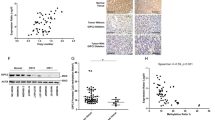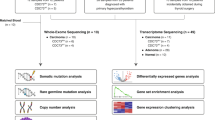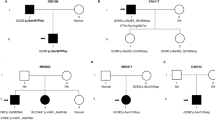Abstract
Inactivation of the HRPT2 gene encoding parafibromin was recently linked to the familial hyperparathyroidism-jaw tumor syndrome. Patients with this syndrome carry an increased risk of parathyroid and renal tumors. To determine the relevance of HRPT2 for sporadic renal tumors, clear cell, papillary and chromophobe renal cell carcinomas as well as oncocytomas and Wilms tumors were analysed for HRPT2 gene alterations. Loss of heterozygosity (LOH) of HRPT2 was found in seven of 56 (12.5%) clear cell, three of 14 (21%) papillary, six of 10 (60%) chromophobe renal cell carcinomas, three of eight (38%) oncocytomas and four of 10 (40%) Wilms tumors. In addition, two novel HRPT2 point mutations, causing K34Q and R292K changes in parafibromin, were detected in one clear cell carcinoma and one Wilms tumor, respectively. These tumors displayed LOH of the remaining wild-type allele, but interestingly no von Hippel–Lindau (VHL) mutation. Functional analysis revealed that the K34Q mutant species of parafibromin is, unlike wild-type protein, defective in suppressing cyclin D1 expression in vivo. Taken together, these results suggest that renal cancer-associated mutations in parafibromin occur in the absence of VHL mutation, which in turn may contribute to constitutively elevated cyclin D1 expression and abnormal cell proliferation.
This is a preview of subscription content, access via your institution
Access options
Subscribe to this journal
Receive 50 print issues and online access
$259.00 per year
only $5.18 per issue
Buy this article
- Purchase on Springer Link
- Instant access to full article PDF
Prices may be subject to local taxes which are calculated during checkout




Similar content being viewed by others
References
Brauch H, Weirich G, Brieger J, Glavac D, Rodl H, Eichinger M . (2000). VHL alterations in human clear cell renal cell carcinoma: association with advanced tumor stage and a novel hot spot mutation. Cancer Res 60: 1942–1948.
Bugert P, Gaul C, Weber K, Herbers J, Akhtar M, Ljungberg B et al. (1997). Specific genetic changes of diagnostic importance in chromophobe renal cell carcinomas. Lab Invest 76: 203–208.
Call KM, Glaser T, Ito CY, Buckler AJ, Pelletier J, Haber DA et al. (1990). Isolation and characterization of a zinc finger polypeptide gene at the human chromosome 11 Wilms’ tumor locus. Cell 60: 509–520.
Carling T . (2001). Molecular pathology of parathyroid tumors. Trends Endocrinol Metab 12: 53–58.
Carpten JD, Robbins CM, Villablanca A, Forsberg L, Presciuttini S, Bailey-Wilson J et al. (2002). HRPT2, encoding parafibromin, is mutated in hyperparathyroidism-jaw tumor syndrome. Nat Genet 32: 676–680.
Cavaco BM, Barros L, Pannett AA, Ruas L, Carvalheiro M, Ruas MM et al. (2001). The hyperparathyroidism-jaw tumour syndrome in a Portuguese kindred. Qjm 94: 213–222.
Cavaco BM, Guerra L, Bradley KJ, Carvalho D, Harding B, Oliveira A et al. (2004). Hyperparathyroidism-jaw tumor syndrome in Roma families from Portugal is due to a founder mutation of the HRPT2 gene. J Clin Endocrinol Metab 89: 1747–1752.
Cetani F, Pardi E, Borsari S, Viacava P, Dipollina G, Cianferotti L et al. (2004). Genetic analyses of the HRPT2 gene in primary hyperparathyroidism: germline and somatic mutations in familial and sporadic parathyroid tumors. J Clin Endocrinol Metab 89: 5583–5591.
Cohen HT, McGovern FJ . (2005). Renal-cell carcinoma. N Engl J Med 353: 2477–2490.
Eble JN, Sauter G, Epstein JI, Sesterhenn IA . (2004). In: Kleihues P, Sobin LH (eds). Pathology and Genetics of Tumours of the Urinary System and Male Genital Organs: World Health Organization Classification of Tumours. IARC Press: Lyon, France, p 359.
Foster K, Prowse A, van den Berg A, Fleming S, Hulsbeek MM, Crossey PA et al. (1994). Somatic mutations of the von Hippel–Lindau disease tumour suppressor gene in non-familial clear cell renal carcinoma. Hum Mol Genet 3: 2169–2173.
Fuzesi L, Frank D, Nguyen C, Ringert RH, Bartels H, Gunawan B . (2005). Losses of 1p and chromosome 14 in renal oncocytomas. Cancer Genet Cytogenet 160: 120–125.
Gessler M, Konig A, Arden K, Grundy P, Orkin S, Sallan S et al. (1994). Infrequent mutation of the WT1 gene in 77 Wilms’ Tumors. Hum Mutat 3: 212–222.
Gessler M, Poustka A, Cavenee W, Neve RL, Orkin SH, Bruns GA . (1990). Homozygous deletion in Wilms tumours of a zinc-finger gene identified by chromosome jumping. Nature 343: 774–778.
Gnarra JR, Tory K, Weng Y, Schmidt L, Wei MH, Li H et al. (1994). Mutations of the VHL tumour suppressor gene in renal carcinoma. Nat Genet 7: 85–90.
Grundy PE, Telzerow PE, Breslow N, Moksness J, Huff V, Paterson MC . (1994). Loss of heterozygosity for chromosomes 16q and 1p in Wilms’ tumors predicts an adverse outcome. Cancer Res 54: 2331–2333.
Grundy RG, Pritchard J, Scambler P, Cowell JK . (1998). Loss of heterozygosity on chromosome 16 in sporadic Wilms’ tumour. Br J Cancer 78: 1181–1187.
Gstaiger M, Luke B, Hess D, Oakeley EJ, Wirbelauer C, Blondel M et al. (2003). Control of nutrient-sensitive transcription programs by the unconventional prefoldin URI. Science 302: 1208–1212.
Hahn MA, Marsh DJ . (2005). Identification of a functional bipartite nuclear localization signal in the tumor suppressor parafibromin. Oncogene 24: 6241–6248.
Haven CJ, Wong FK, van Dam EW, van der Juijt R, van Asperen C, Jansen J et al. (2000). A genotypic and histopathological study of a large Dutch kindred with hyperparathyroidism-jaw tumor syndrome. J Clin Endocrinol Metab 85: 1449–1454.
Herman JG, Latif F, Weng Y, Lerman MI, Zbar B, Liu S et al. (1994). Silencing of the VHL tumor-suppressor gene by DNA methylation in renal carcinoma. Proc Natl Acad Sci USA 91: 9700–9704.
Hing S, Lu YJ, Summersgill B, King-Underwood L, Nicholson J, Grundy P et al. (2001). Gain of 1q is associated with adverse outcome in favorable histology Wilms’ tumors. Am J Pathol 158: 393–398.
Howell VM, Haven CJ, Kahnoski K, Khoo SK, Petillo D, Chen J et al. (2003). HRPT2 mutations are associated with malignancy in sporadic parathyroid tumours. J Med Genet 40: 657–663.
Jackson CE, Norum RA, Boyd SB, Talpos GB, Wilson SD, Taggart RT et al. (1990). Hereditary hyperparathyroidism and multiple ossifying jaw fibromas: a clinically and genetically distinct syndrome. Surgery 108: 1006–1012; discussion 1012–1003.
Jemal A, Murray T, Ward E, Samuels A, Tiwari RC, Ghafoor A et al. (2005). Cancer statistics, 2005. CA Cancer J Clin 55: 10–30.
Jiang F, Richter J, Schraml P, Bubendorf L, Gasser T, Sauter G et al. (1998). Chromosomal imbalances in papillary renal cell carcinoma: genetic differences between histological subtypes. Am J Pathol 153: 1467–1473.
Kakinuma A, Morimoto I, Nakano Y, Fujimoto R, Ishida O, Okada Y et al. (1994). Familial primary hyperparathyroidism complicated with Wilms’ tumor. Intern Med 33: 123–126.
Khoo SK, Kahnoski K, Sugimura J, Petillo D, Chen J, Shockley K et al. (2003). Inactivation of BHD in sporadic renal tumors. Cancer Res 63: 4583–4587.
Kiuru M, Lehtonen R, Arola J, Salovaara R, Jarvinen H, Aittomaki K et al. (2002). mutations in sporadic counterparts of tumor types observed in hereditary leiomyomatosis and renal cell cancer families. Cancer Res 62: 4554–4557.
Klamt B, Schulze M, Thate C, Mares J, Goetz P, Kodet R et al. (1998). Allele loss in Wilms tumors of chromosome arms 11q, 16q, and 22q correlate with clinicopathological parameters. Genes Chromosomes Cancer 22: 287–294.
Kovacs A, Kovacs G . (1992). Low chromosome number in chromophobe renal cell carcinomas. Genes Chromosomes Cancer 4: 267–268.
Kovacs G, Fuzesi L, Emanual A, Kung HF . (1991). Cytogenetics of papillary renal cell tumors. Genes Chromosomes Cancer 3: 249–255.
Krek W, Livingston DM, Shirodkar S . (1993). Binding to DNA and the retinoblastoma gene product promoted by complex formation of different E2F family members. Science 262: 1557–1560.
Latif F, Tory K, Gnarra J, Yao M, Duh FM, Orcutt ML et al. (1993). Identification of the von Hippel–Lindau disease tumor suppressor gene. Science 260: 1317–1320.
Law MH, Algar E, Little M . (1997). Allelic imbalance at chromosome 1q21 in Wilms tumor. Cancer Genet Cytogenet 97: 54–59.
Maiti S, Alam R, Amos CI, Huff V . (2000). Frequent association of beta-catenin and WT1 mutations in Wilms tumors. Cancer Res 60: 6288–6292.
Meloni AM, Sandberg AA, White RD . (1992). Y,-1 as recurrent anomaly in oncocytoma. Cancer Genet Cytogenet 61: 108–109.
Moch H, Presti Jr JC, Sauter G, Buchholz N, Jordan P, Mihatsch MJ et al. (1996). Genetic aberrations detected by comparative genomic hybridization are associated with clinical outcome in renal cell carcinoma. Cancer Res 56: 27–30.
Moch H, Schraml P, Bubendorf L, Richter J, Gasser TC, Mihatsch MJ et al. (1998). Intratumoral heterogeneity of von Hippel–Lindau gene deletions in renal cell carcinoma detected by fluorescence in situ hybridization. Cancer Res 58: 2304–2309.
Mosimann C, Hausmann G, Basler K . (2006). Parafibromin/Hyrax activates Wnt/Wg target gene transcription by direct association with beta-catenin/Armadillo. Cell 125: 327–341.
Nagy A, Buzogany I, Kovacs G . (2004). Microsatellite allelotyping differentiates chromophobe renal cell carcinomas from renal oncocytomas and identifies new genetic changes. Histopathology 44: 542–546.
Natrajan R, Williams R, Hing S, Mackay A, Reis-Filho J, Fenwick K et al. (2006). Array CGH profiling of favourable histology Wilms tumours reveals novel gains and losses associated with relapse. J Pathol 210: 49–58.
Nickerson ML, Warren MB, Toro JR, Matrosova V, Glenn G, Turner ML et al. (2002). Mutations in a novel gene lead to kidney tumors, lung wall defects, and benign tumors of the hair follicle in patients with the Birt–Hogg–Dube syndrome. Cancer Cell 2: 157–164.
Pavlovich CP, Schmidt LS . (2004). Searching for the hereditary causes of renal-cell carcinoma. Nat Rev Cancer 4: 381–393.
Perren A, Schmid S, Locher T, Saremaslani P, Bonvin C, Heitz PU et al. (2004). BRAF and endocrine tumors: mutations are frequent in papillary thyroid carcinomas, rare in endocrine tumors of the gastrointestinal tract and not detected in other endocrine tumors. Endocr Relat Cancer 11: 855–860.
Presti Jr JC, Moch H, Reuter VE, Huynh D, Waldman FM . (1996). Comparative genomic hybridization for genetic analysis of renal oncocytomas. Genes Chromosomes Cancer 17: 199–204.
Reutzel D, Mende M, Naumann S, Storkel S, Brenner W, Zabel B et al. (2001). Genomic imbalances in 61 renal cancers from the proximal tubulus detected by comparative genomic hybridization. Cytogenet Cell Genet 93: 221–227.
Rivera MN, Haber DA . (2005). Wilms’ tumour: connecting tumorigenesis and organ development in the kidney. Nat Rev Cancer 5: 699–712.
Rozenblatt-Rosen O, Hughes CM, Nannepaga SJ, Shanmugam KS, Copeland TD, Guszczynski T et al. (2005). The parafibromin tumor suppressor protein is part of a human Paf1 complex. Mol Cell Biol 25: 612–620.
Schmidt L, Duh FM, Chen F, Kishida T, Glenn G, Choyke P et al. (1997). Germline and somatic mutations in the tyrosine kinase domain of the MET proto-oncogene in papillary renal carcinomas. Nat Genet 16: 68–73.
Schmidt L, Junker K, Nakaigawa N, Kinjerski T, Weirich G, Miller M et al. (1999). Novel mutations of the MET proto-oncogene in papillary renal carcinomas. Oncogene 18: 2343–2350.
Schraml P, Struckmann K, Hatz F, Sonnet S, Kully C, Gasser T et al. (2002). VHL mutations and their correlation with tumour cell proliferation, microvessel density, and patient prognosis in clear cell renal cell carcinoma. J Pathol 196: 186–193.
Shattuck TM, Valimaki S, Obara T, Gaz RD, Clark OH, Shoback D et al. (2003). Somatic and germ-line mutations of the HRPT2 gene in sporadic parathyroid carcinoma. N Engl J Med 349: 1722–1729.
Shuin T, Kondo K, Torigoe S, Kishida T, Kubota Y, Hosaka M et al. (1994). Frequent somatic mutations and loss of heterozygosity of the von Hippel–Lindau tumor suppressor gene in primary human renal cell carcinomas. Cancer Res 54: 2852–2855.
Speicher MR, Schoell B, du Manoir S, Schrock E, Ried T, Cremer T et al. (1994). Specific loss of chromosomes 1, 2, 6, 10, 13, 17, and 21 in chromophobe renal cell carcinomas revealed by comparative genomic hybridization. Am J Pathol 145: 356–364.
Szabo J, Heath B, Hill VM, Jackson CE, Zarbo RJ, Mallette LE et al. (1995). Hereditary hyperparathyroidism-jaw tumor syndrome: the endocrine tumor gene HRPT2 maps to chromosome 1q21–q31. Am J Hum Genet 56: 944–950.
Teh BT, Farnebo F, Kristoffersson U, Sundelin B, Cardinal J, Axelson R et al. (1996). Autosomal dominant primary hyperparathyroidism and jaw tumor syndrome associated with renal hamartomas and cystic kidney disease: linkage to 1q21–q32 and loss of the wild type allele in renal hamartomas. J Clin Endocrinol Metab 81: 4204–4211.
Tomlinson IP, Alam NA, Rowan AJ, Barclay E, Jaeger EE, Kelsell D et al. (2002). Germline mutations in FH predispose to dominantly inherited uterine fibroids, skin leiomyomata and papillary renal cell cancer. Nat Genet 30: 406–410.
Varanasi R, Bardeesy N, Ghahremani M, Petruzzi MJ, Nowak N, Adam MA et al. (1994). Fine structure analysis of the WT1 gene in sporadic Wilms tumors. Proc Natl Acad Sci USA 91: 3554–3558.
Wang PF, Tan MH, Zhang C, Morreau H, Teh BT . (2005). HRPT2, a tumor suppressor gene for hyperparathyroidism-jaw tumor syndrome. Horm Metab Res 37: 380–383.
Wiznerowicz M, Trono D . (2003). Conditional suppression of cellular genes: lentivirus vector-mediated drug-inducible RNA interference. J Virol 77: 8957–8961.
Woodard GE, Lin L, Zhang JH, Agarwal SK, Marx SJ, Simonds WF . (2005). Parafibromin, product of the hyperparathyroidism-jaw tumor syndrome gene HRPT2, regulates cyclin D1/PRAD1 expression. Oncogene 24: 1272–1276.
Yart A, Gstaiger M, Wirbelauer C, Pecnik M, Anastasiou D, Hess D et al. (2005). The HRPT2 tumor suppressor gene product parafibromin associates with human PAF1 and RNA polymerase II. Mol Cell Biol 25: 5052–5060.
Acknowledgements
We thank Sonja Schmidt, Silvia Behnke and Martina Storz for technical assistance and staffs of our Molecular Diagnostic Laboratory for sequencing. We are also grateful to Nobert Wey for help with photographic and computer-assisted reproduction and to Dr Adriana von Teichman for English correction. AY is the recipient of a long-term Marie Curie intra-European fellowship. The study was supported by UBS AG (made possible by an anonymous donor), the Swiss National Science Foundation and the Zurich Cancer League, Switzerland.
Author information
Authors and Affiliations
Corresponding author
Rights and permissions
About this article
Cite this article
Zhao, J., Yart, A., Frigerio, S. et al. Sporadic human renal tumors display frequent allelic imbalances and novel mutations of the HRPT2 gene. Oncogene 26, 3440–3449 (2007). https://doi.org/10.1038/sj.onc.1210131
Received:
Revised:
Accepted:
Published:
Issue Date:
DOI: https://doi.org/10.1038/sj.onc.1210131
Keywords
This article is cited by
-
Crystal structure of the N-terminal domain of human CDC73 and its implications for the hyperparathyroidism-jaw tumor (HPT-JT) syndrome
Scientific Reports (2017)
-
CDC73 gene mutations in sporadic ossifying fibroma of the jaws
Diagnostic Pathology (2016)
-
Hereditäre Nierentumoren
Der Pathologe (2016)
-
Genomic expression and single-nucleotide polymorphism profiling discriminates chromophobe renal cell carcinoma and oncocytoma
BMC Cancer (2010)



